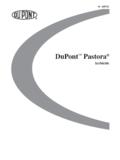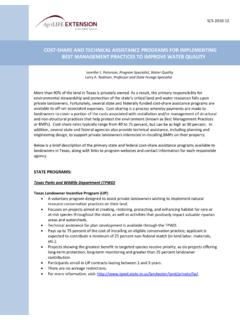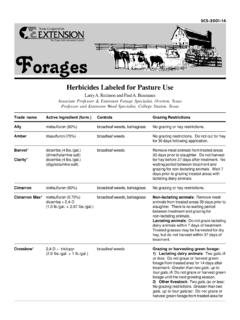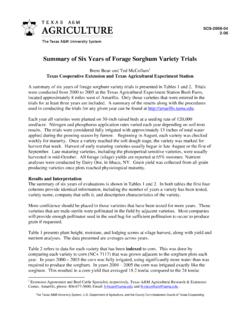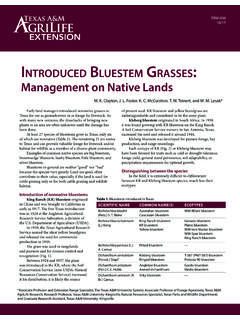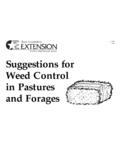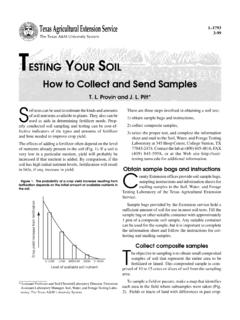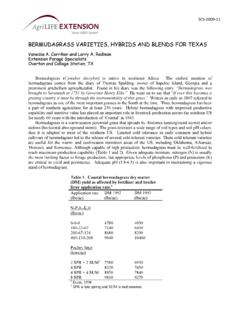Transcription of Chemical Weed and Brush Control Suggestions for Rangeland
1 Chemical Weed and Brush Control Suggestions for Rangeland Allan McGinty, J. F.. Cadenhead, Wayne Hamilton, Wayne C. Hanselka, Darrell N. Ueckert and Steven G. Whisenant*. This publication is intended to provide general Suggestions helpful. EXSEL is a decision support expert system designed for herbicide use to Control Brush and weeds on Texas range- to recommend the best mechanical and Chemical range Brush lands and information on the levels of Control expected. The and weed Control treatments in Texas. It also provides an information is presented in good faith, but no warranty, analysis of prescription fire potential and will produce a pre- express or implied, is given. Weed and Brush Control results burn checklist. The user may select the desired plant-kill effi- may vary tremendously if treatments are applied under less cacy level, force the system to consider certain types of treat- than optimum conditions.
2 Ments, or let the system choose the best alternative. EXSEL. Users of this publication may find the Expert System for is on the World Wide Web ( ) and Brush and Weed Control Technology Selection (EXSEL) can be accessed free of charge. Tommy Welch, former Associate Department Head; Professor and Extension Program Leader for Rangeland Ecology and Management was the original author of this publication. After his retirement in 1995, the Herbicide Use Committee , Rangeland Ecology and Management (members listed above), assumed the responsibility for updating and maintaining this publication. *Professor and Extension Range Specialist; Assistant Professor and Extension Range and Brush Control Specialist; Senior Lecturer, Rangeland Ecology and Management; Associate Department Head, Professor and Extension Program Leader; Professor, Texas Agricultural Experiment Station; and Professor, Rangeland Ecology and Management; The Texas A&M University System.
3 Chemical Weed and Brush Control on Rangeland Index Control descriptions for weed and Brush plants are located on the page numbers indicated. Carefully check the chart. More than one Control measure may exist. Weed species Page Twoleaf senna ..11 ,16. Upright prairie-coneflower ..8,11 Honeylocust ..16. Berlandier Western bitterweed ..6 Huisache ..13, 15,16,17,18,22. Bitter Western Lotebush ..13,15. Broomweed (annual or common)..4, 5, 6 Western Macartney rose ..17,18. Broom snakeweed ..7 Wild carrot ..6 ,19,20,21,22. Mesquite,Western Bullnettle ..8 Woolly Mixed Brush - South Texas ..22. Camphorweed ..6 Mixed Brush - Davis Mountains ..22. Carolina Mohrs shinoak ..22. Cocklebur ..6 Brush species Page Post Common Pricklyash (Hercules club)..13,15. Croton ..6 Ashe juniper ..12 ,24. Baccharis ..12,13 Redberry cedar ..12,24. Drummond's goldenweed ..8 Beebrush ..13,26 Redberry ,24. Bee-bush ..13,26 ,22. Gray Bigelow shinoak.
4 13 Roosevelt willow ..12,13. Horehound ..6 ,22 Running live Blackgum ..14 Blackjack 6 Blueberry cedar ..12 Sand Narrowleaf goldaster ..9,10 Bois d'arc ..13 Sand shinnery oak ..26. Perennial Catclaw acacia ..13,22 Seep ,13. Catclaw mimosa ..13,14,22 Skunkbush ..22. Prairie Cenizo ..14 Spiny hackberry ..15,22. Chinese tallowtree ..13,14 Rayless goldenrod ..10 Cholla ..12 Rosin weed ..8 Common persimmon ..15 ,22. Silverleaf Texas Dog Twisted , 22. Spiny Dryland willow ..12 White shinoak ..13. Eastern Whitebrush ..13,22,26. Sumpweed ..6 Eastern redcedar ..15 Whitethorn Elm ..13,15 Willow ..13. Tallowweed ..6 Flameleaf sumac ..16 Willow ,13. Thistles ..6 Granjeno ..15,22 Winged Threadleaf groundsel ..9,10 Greenbriar ..13,16 ,15. ,22 Twinleaf Hackberry ..13,15. Chemical Weed and Brush Control on Rangeland 2. M. illions of acres of Texas Rangeland support an excessive cover of undesir- The sprayer used must apply the correct quantity of herbicide mixture to a spe- able woody plants and forbs.
5 Dense stands of Brush and weeds use valu- cific area. To calibrate spray equipment, see Extension publication B-1648, Private able water for growth, reduce grass production and result in soil erosion. Applicator General Manual. For information on mixing herbicides, see L-1839, These noxious plants must be managed effectively for rangelands to reach their pro- Mixing instructions for Liquid Herbicides.. ductive potential. Use of herbicides provides an effective and efficient alternative Suggestions on use of herbicides made by the Texas Agricultural Extension for controlling Brush and weeds for improvement and maintenance of rangelands in Service are based upon effectiveness under Texas conditions. a highly productive condition. Broadcast and individual plant treatments are presented in Table 1 and Table 2. This publication lists current Suggestions for herbicide use to Control Brush and Individual plant treatments are suited for Control of thin stands of Brush and selec- weeds on Rangeland .
6 Some herbicides provide a high degree of Control of certain tive Control . Broadcast treatments are useful for dense stands of Brush and for weed species; however, seldom is a species eradicated. Consider other potential Rangeland Control . uses when developing a Brush management program. Many trees, shrubs and forbs Suggested herbicides must be registered and labeled for use by the are valuable as food and cover for wildlife and may be an important component in Environmental Protection Agency. Because the status of herbicide label clearance is livestock diets. Therefore, a Brush management program should provide for use of subject to change, be certain that the herbicide is currently labeled for the intended . use Control methods that give optimum benefits to livestock and wildlife. The user is always responsible for the effects of herbicide residue on his live- Herbicide application may increase palatability of poisonous plants.
7 Thus, they stock and crops, as well as for problems that could arise from drift or movement of are more likely to be consumed by livestock. To prevent losses to toxic plants, herbi- the herbicide from his property to that of others. Always read and follow carefully the cide-treated areas with poisonous plants present should not be grazed until the toxic instructions on the container label. plants dry up and lose their palatability. Properly used herbicides are effective and safe. Misuse can result in poor Brush and weed Control and possible hazards associated with herbicidal drift or residues Treatment Control Ratings such as killing of desirable plants. Listed below are points to follow for proper her- bicide use: A Control rating, based on the effectiveness of a herbicide treatment in controlling a Identify the weed or Brush species and evaluate the need for Control . target plant, has been given to each herbicide use suggestion.
8 These ratings were Consider expected benefits, costs and alternative Control practices. determined from research and result demonstration data and from observations of commercial applications. The rating represents a degree of plant mortality of the tar- Select and purchase the suggested herbicide for the weed or Brush species. get plant species when the treatment is properly applied under optimum conditions. Provide and require the use of proper safety equipment. The rating categories and degree of plant mortality are: Calibrate spray equipment. Mix herbicides in a ventilated area, preferably outside. Control rating Percent of plants killed Spray under conditions that minimize drift to susceptible crops. Very high 76-100. Apply the herbicides at the suggested rate and time. High 56-75. Keep a record of the herbicide used, the time required to spray, weather con- Moderate 36-55. ditions, rate of herbicide in carrier, date and location and the person using the Low 0-35.
9 Herbicide. Chemical Weed and Brush Control on Rangeland 3. Common, Chemical and Product Names of Herbicides*. Herbicide common name Chemical name Product name Active ingredient or acid equivalent Clopyralid 3,6-dichloro-2-pyridinecarboxylic acid Reclaim 3 2,4-D (2,4-dichlorophenoxy) acetic acid Several including Weedar 64, amine salts and esters Formula 40,Hi-Dep, Weedone LV4,Esteron 99C. and others Dicamba 3,6-dichloro-2-methoxybenzoic acid Banvel 4 Dicamba:2,4-D(1:3) See dicamba and 2,4-D Weedmaster 4 Diesel fuel oil or kerosene refined petroleum fractions Several manufacturers Glyphosate N-(phosphonomethyl) glycine Several including Rodeo, Roundup, isopropylamine salt*, Roundup Ultra,Glypro, Glyphos concentration and others varies depending on the product Hexazinone 3-cyclohexyl-6-(dimethylamino)-1-methyl- 1,3,5-triazine-2,4(1H,3H)-dione Velpar L 2 Imazapyr 2-[4,5-dihydro-4-methyl-4-(1-methylethyl )-5-oxo-1H-imidazol-2-yl]-3- Arsenal 2 pyridinecarboxylic acid Metsulfuron methyl methyl 2-[[[[(4-methoxy-6-methyl-1,3,5-triazin- 2-yl)amino]carbonyl].]]
10 Amino] sulfonyl] benzoate Ally, Escort 60%. Paraquat 1,1'-dimethyl-4,4'-bipyridinium dichloride Gramoxone Extra Picloram 4-amino-3,5,6-trichloro-2-pyridinecarbox ylic acid Tordon 22K 2 Picloram:2,4-D(1:4) See picloram and 2,4-D Grazon P+D Tebuthiuron N-[5-(1,1-dimethylethyl)-1,3,4-thiadiazo l-2-yl]-N,N'-dimethylurea Spike 20P 20%. Triclopyr [(3,5,6-trichloro-2-pyridinyl)oxy]acetic acid Remedy 4 Triclopyr:2,4-D(1:2) See triclopyr and 2,4-D Crossbow 3 *Herbicides have been identified by the accepted Weed Science Society of America common name, other common designation,the correct names required on the label,and when practical,one or more product names. For herbicides marketed under three or more labels,the designation several manufacturers has been used rather than attempting to list all the trade formulations. Common Measurement Conversions for Use with Herbicide Applications Liquid Weight 1 gallon (gal) = 4 quarts (qt) 1 pint = 16 ounces 1 pound (lb) = 16 ounces 1 gallon = 8 pints (pt) 1 pint = milliliters 1 pound = grams (g).

